Draft mode is now here! Vainglory is many players’ first experience with the MOBA genre, which also means that this is their first time using draft mode. For others, it may be their first time using draft mode in a 3v3 style MOBA. We at Broken Myth are excited to present a drafting guide to help prepare everyone for this big change! As an added bonus, we’ve also made sure to cover the most common team comp archetypes.
For those of you who don’t know me, I’m fedmattisgg. I have been playing different MOBAs competitively over the course of six years and have served as a head analyst/coach in the semi-pro League of Legends scene. Over the course of my gaming career, the draft phase has become one of my specialties. My objective is to impart as much of my knowledge to you as possible, with the remainder being learned through your own firsthand experience.
To help this guide remain relevant and timeless, it has been written to not be specific to any particular meta. Additionally, this guide will be focused on ranked queue – where you do not know the identities of your opponents. Tournament strategy is a different animal and will be covered in a separate guide.
Key Terms and Phrases:
[su_accordion]
[su_spoiler title=”Flex Pick” style=”fancy”]A flex pick is exactly what it sounds like: a hero that is flexible with which roles can be played. Flex picks are very strong in a draft because they can throw your opponents off-guard. A hero that is equally as strong in lane as they are in the jungle can put a lot of pressure on the opponents decisions and strategies.
As an example, Glaive can be played as a laner, a jungler, or even as a roamer. This can create uncertainty for opponents and make it difficult for them to react. For example, if your opponents assume you’ll be running Glaive in lane and pick a good lane counter for him, you could simply place Glaive in the jungle instead and use it as an opportunity to pick a counter to their laner.[/su_spoiler]
[su_spoiler title=”Comfort Pick” style=”fancy”]Comfort picks are heroes in the game that you and/or your teammates are comfortable playing. These are your strongest heroes, the ones you have played and practiced the most. Comfort picks are very important in the draft phase because you know the strengths and weaknesses of your hero in a large variety of situations and against a large variety of opponents. This allows you to play smarter, even in tough circumstances.[/su_spoiler]
[su_spoiler title=”Priority Pick/Ban” style=”fancy”]For purposes of ranked queue, priority picks and bans are just another name for OP – “overpowered” – heroes. For the most part, these consist of the really strong meta picks; the heroes that have to be taken away in the ban phase or the heroes that have to be picked when left open. These picks or bans are simply a priority. They can also be picks that “make or break” certain team comps or players.[/su_spoiler]
[su_spoiler title=”Luxury Pick” style=”fancy”]Luxury picks are when it’s your turn to select two heroes – often contested picks – and you’re able to lock in a powerful hero combo as the foundation of your team comp. Oftentimes this synergistic double pick can be used as a counter to your opponents’ pick(s).[/su_spoiler]
[su_spoiler title=”Vulnerability Ban” style=”fancy”]Some players just have that one hero that is just the bane of their existence. For whatever reason, they just can’t seem to ever do well against this hero or it is just by far the one they have the most trouble with. A vulnerability ban is dedicated to taking away this hero specifically, so that you (or your teammate) does not need to deal with hit. However, it comes with great cost because it also takes away the option of a priority or “top of the meta” ban.[/su_spoiler]
[su_spoiler title=”Power Spike” style=”fancy”]Different heroes hit “power spikes” at different points in the game when they level up crucial skills or pick up certain items which make them much stronger. Generally speaking, you can categorize a hero’s power spike into early, mid, or late-game, but power spikes can come earlier or later depending on the pace of the game. Knowing when different heroes hit power spikes can be crucial for a good draft; good comps need to be cohesive, not just made of strong picks. For example, if you pick two heroes who are are strong in the early-game and one hero who is strong in the late-game, your power spikes will be out of sync and make it difficult to have a strong presence at either phase of the game.[/su_spoiler]
[/su_accordion]
If you’re experienced with drafting, you may have noticed that I did not include target bans or steals. For the purposes of this article, we are assuming that our opponents are completely unknown. If you have the luxury of sniping someone in ranked queue, then it is definitely a strong option to target ban or steal that hero away to prevent that player from getting their best power pick.
Now that we have some important key phrases down, we can start going over some strategies.
Step 1: Assessing Your Team
The absolute first thing you need to do before even worrying about the draft phase is finding out who and how your teammates play. Getting one of the most overpowered compositions in the game is great, but could be a bad idea if your teammates are playing roles they aren’t used to. While it is not essential that everyone always play the same role, it is important to know your teammates’ capabilities. Make sure that each of you understand each others’ hero pools and preferred roles so that you can draft effectively.
Voice communication is highly encouraged, as it will greatly increase your drafting effectiveness! My best advice if you are not using voice is to talk about these strategies before queuing up, so that you have a generic idea of what your team wants to do. From there, use the “thumbs up” option and role indicator to try to communicate which strategies you are using.
Reminder: don’t forget you can trade heroes once the draft is over, so it’s very possible you may end up picking a hero for one of your teammates and vice versa.
Step 2: The Bans and First Round Draft
Important drafting principles
While still maintaining a cohesive team comp of your own, attack your opponents’ strategy whenever possible. Your picks should usually be aimed at countering your opponent, even when not explicitly stated.
For the most part, it is nearly impossible to stop your opponent from getting a priority pick, and this is not something to worry about. When that happens, it is your opportunity to manage the situation and turn things back in your favor – competitive teams do this all the time. Priority picks are much stronger when they have a proper composition, and you can try to prevent them from making that happen. Additionally, some priority picks have strong counters which you can draft to shut down a priority pick. One way or another, when your opponent obtains a priority pick, the draft gives you some control over how strong that pick will be.
No strategy is perfect. All of these strategies have pros and cons. They are here to give you some basic ideas and concepts that can be used when drafting. Use the ones you like the best or have the most success with. ANY of them can work. However, it is important to know the strong and weak points of your approach.
Strategies for First Ban/Pick
- The general strategy is to leverage your tempo, either keeping your opponents guessing and forcing them to react.
- Flex picks are strongest at this part of the drafting phase
- This is your best opportunity to guarantee a priority pick.
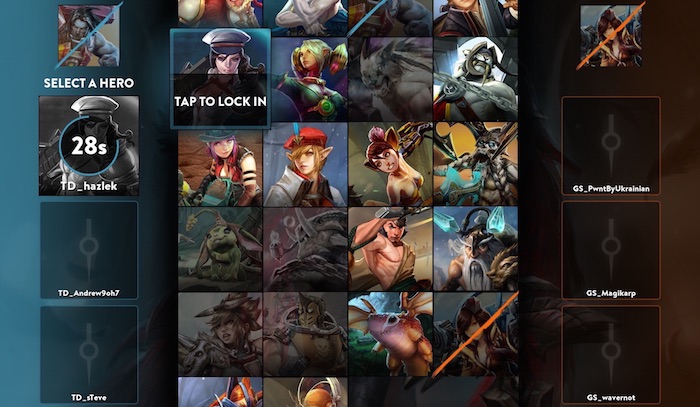
[su_accordion]
[su_spoiler title=”Priority Ban (Roam) | Priority Pick (Roam)” style=”fancy”]This is one of the most popular strategies in competitive play when first-picking. At most points in the meta, there are usually two really strong roam picks, with the remaining options not as favorable. The strategy here is to ban one of the strongest roamers and pick the other one.
[su_row]
[su_column size=”1/2″]Pros:
Forces your opponents onto second-tier roam picks.
Gives very little competitive insight to help your opponents with their drafting strategy – roam picks often don’t point to a direct style of team composition.
Allows you to stall out the drafting phase to get a better feel for what your opponent wants to run.
[/su_column]
[su_column size=”1/2″]Cons:
Allows your opponent to get strong luxury picks (remember what I said above).
While stealing away the good roam heroes can force your opponent onto a less favorable pick, they are generally not the powerhouses of compositions. A team can be very strong with the combination of a good jungler and laner who mesh well.
[/su_column]
[/su_row]
[/su_spoiler]
[su_spoiler title=”Priority Ban | Flex Pick” style=”fancy”]Is someone on your team good with strong flex pick hero? A good strategy is to ban an strong meta pick and then pick a hero that can effectively play multiple roles.
[su_row]
[su_column size=”1/2″]Pros:
Flex picks usually don’t give your opponents much insight into your drafting strategy.
Since flex picks can be shifted to fit multiple roles, they can be a method of preemptively countering your opponent.
The priority ban limits your opponents’ options for luxury picks.
[/su_column]
[su_column size=”1/2″]Cons:
While flex picks are very strong in draft, they can also lead to your own downfall. The biggest mistake that teams make when using flex picks is that they don’t line up a good comp around it. You must be aware that you need an overarching theme for your team comp, not just strong picks. For example, Glaive is a great flex pick and has different match up strengths in each role. Even if the optimal spot for him is in the jungle, there may not be any laners available that complement a Glaive duo jungle pair.
[/su_column]
[/su_row]
[/su_spoiler]
[su_spoiler title=”Vulnerability Ban | Priority Comfort Pick” style=”fancy”]This strategy is for scenarios where you or one of your teammates is fantastic with an in-meta hero, but it is a highly contested priority pick. To complicate matters further, there’s one opposing hero that almost always makes their life a nightmare. This strategy revolves around getting a specific hero for a specific member at all costs and banning out that teammate’s vulnerability.
[su_row]
[su_column size=”1/2″]Pros:
Your teammate gets their favorite comfort pick and you remove their least favorite opposition from the picture. This puts your teammate is a great position to have a massive impact for your team.
If it turns out that this pick happens to be the crux of a desired team composition, this is an important victory.
Locking in a priority pick prevents your opponents from getting it.
[/su_column]
[su_column size=”1/2″]Cons:
By revealing a priority pick so early, it may make you susceptible to other counter picks.
By locking in a lane or jungle carry first, it can signal to your opponents what you might be intending for a team composition or draft strategy, allowing them to craft a counter strategy.
[/su_column]
[/su_row]
[/su_spoiler]
[su_spoiler title=”Priority or Vulnerability Ban | Priority Pick” style=”fancy”]The main point of this simple strategy is to steal a very strong meta pick from the other team. The ban is flexible, depending on what you want to prevent the opposition from having.
[su_row]
[su_column size=”1/2″]Pros:
Simply put, you can get a really strong meta pick (possibly the strongest), prevent your opponents from having it, and then force your opponent to deal with it.
[/su_column]
[su_column size=”1/2″]Cons:
As mentioned earlier in the guide, having a top priority pick doesn’t guarantee success – it usually requires a synergistic team comp. After your priority pick, your opponents have two picks they can use to steal away key heroes you might need for a good team comp.
[/su_column]
[/su_row]
[/su_spoiler]
[/su_accordion]
Strategies for Second Ban/Double-Pick
- The general strategy is to use your double pick to either counter your opponent or establish a strong foundation for your team comp – maybe both.
- Do your best to force your opponent to react to your picks rather than having them proceed as planned.
- If the other team first-picks a hero that is not flexible – i.e. a hero who is always played in a certain role – do not fear another hero of that same role may be taken away. As an example, if your opponent first-picks a roamer, you could safely pick your jungle and lane and save your roam pick for last without worrying that the other team will take it.
- Flex picks are not as effective because you only have one pick left to flex, which generally does not throw a big curve ball for the other team.

[su_accordion]
[su_spoiler title=”Priority Ban | Double Luxury Pick” style=”fancy”]Probably the most popular strategy when second pick. The idea of this strategy is to priority ban one of the strongest heroes of the meta and pick two heroes that have great synergy, thus forming the core of your team comp.
[su_row]
[su_column size=”1/2″]Pros:
Prevents your opponent from getting a strong priority pick
Enables you to secure a strong team composition. Certain combination of lane and jungle heroes can make any composition strong.
[/su_column]
[su_column size=”1/2″]Cons:
You reveal your composition and purpose in the first round.
The opposing team can respond by selecting viable counters.
[/su_column]
[/su_row]
[/su_spoiler]
[su_spoiler title=”Priority Ban | Roam + Priority Pick” style=”fancy”]The idea of this strategy is very similar to the first. Ban away a very strong meta hero, but this time pick up your roam and either lane or jungle pick.
[su_row]
[su_column size=”1/2″]Pros:
In contrast to the strategy above, by picking a roam instead of two carries, you don’t completely reveal your composition.
By saving a jungle or lane pick for last, it gives your team one last opportunity to counter your opponents once they have chosen all three of their heroes.
[/su_column]
[su_column size=”1/2″]Cons:
You give your opponents more room for luxury picks, possibly stealing away one of the heroes that you could have used for your own team comp.
You may unintentionally give your opponents the freedom to make a ideal team composition.
[/su_column]
[/su_row]
[/su_spoiler]
[su_spoiler title=”Vulnerability Ban | Double Luxury Pick” style=”fancy”]This is my personal favorite strategy. Ban out the pick that your team absolutely hates the most and has the lowest success against. From there, pick two very well-rounded heroes and create a solid foundation for your team. This is also a great way to counter the enemy team when they first-pick a strong hero.
[su_row]
[su_column size=”1/2″]Pros:
Great for bringing out specific compositions. Banning out a pick that causes a lot of problems in lane or is the bane of a certain jungle combo can help magnify this further.
[/su_column]
[su_column size=”1/2″]Cons:
In spite of your ban, you still give a lot of room for your opponents to select good counter picks.
[/su_column]
[/su_row]
[/su_spoiler]
[/su_accordion]
Step 3: Rounding Out the Composition
At this point you are now entering the second round of draft. Specific examples cannot realistically be provided because they are dependent on both your picks and your opponents. However, both teams at this point will have the needed information to effectively round out their composition as planned or counter their opponents.
First Pick – Round Two
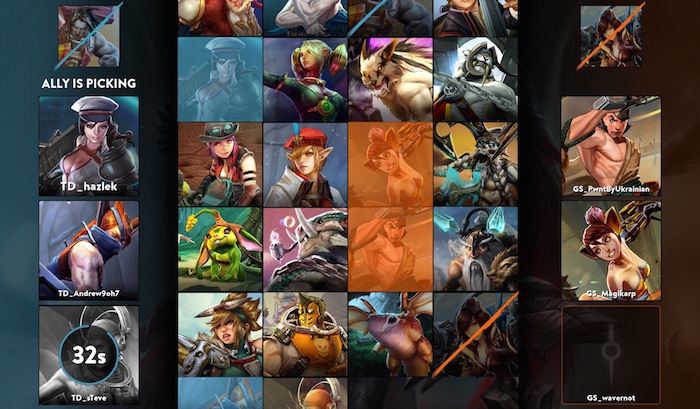
If you were first pick and choose an option that revolved around strong neutral picks or flex picks, now is the time to consider the best way to counter the opponents’ team with what you know. Try to be proactive and predict what you think your opponents might pick. Weigh each option quickly and determine what additional heroes best suit that particular situation.
Remember: make sure your team is balanced! It is not enough to JUST pick counters! Ensure that your team still has a main theme and complementary power spikes. If you picked a strategy which revolves around a certain hero or player, make sure that your next picks compliment that player. As stated before, strong heroes become even stronger when they have a synergistic composition around them.
Second Pick – Round Two
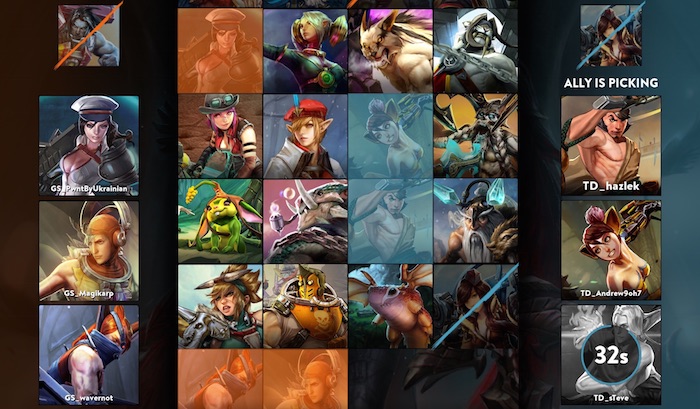
Second pick isn’t all that different from first pick, with the exception that by this point you have seen the entire enemy team. If your last pick is a roamer, make sure that you pick a roam hero that specifically has synergy with either your laner or your jungler. Try your best to construct that common theme between your heroes. Don’t just pick a certain roam hero because it the only “conventional” pick left! There are tons of heroes out there that don’t “normally” roam, but make great roam heroes for certain compositions (think Koshka).
If you chose to pick your roamer and either your laner or jungler, make a pick that you guys are most comfortable with as a team. If you are uncomfortable sending Vox against a Celeste, try picking a different laner or flex as necessary.
Remember: you know their entire team! Nothing will change for them. Counter them as necessary!
Once again, do not forget that when the draft is over you can trade picks (and roles) with your teammates.
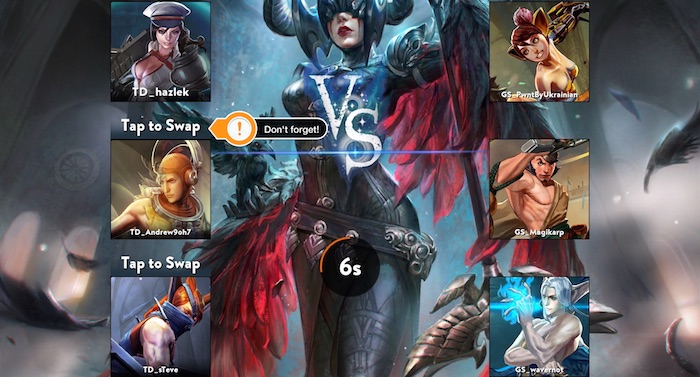
Team Comp Archetypes
Now that you are familiar with drafting strategies, it is now time to get a little bit more advanced. We’ve assembled the Sinister Seven, or the seven most common and effective team composition styles in Vainglory. Each has a clear theme and is independent of the heroes in the meta. Use this list as a resource to help carve out your team comps given the pick and ban strategies you are using. We will not be going over in-game strategies on how to use these comps, but rather provide you with a simple description. These are not the only team composition styles that exist, but are simply the ones that are most prevalent throughout the game. Feel free to experiment with your team!
These styles will likely persist throughout the existence of Vainglory and can be formed using many different combinations of heroes. Utilizing these compositions directly in the draft phase is much more advanced and can take practice mastering; however, it drastically improves your drafting strengths when implemented. Also, many of these styles might involve the same or similar heroes, allowing these compositions to be flexed around during the draft phase. In fact, some hero combinations can even fall under more than one style of play.
[su_accordion]
[su_spoiler title=”Wombo Combo” style=”fancy”]Playstyle(s): Late mid- to late-game (passive)
Strength(s): Synergy, AOE, burst
Weakness(es): Early-game aggression, poke, engage, opportunity
Difficulty (1-10): 10
This style of composition revolves around picking massive AOE heroes that can chain certain abilities together to create a massive combo. Wombo combos are often fairly difficult to pull off because they require a near perfect setup and timing. Usually this involves finding optimal engages, not falling behind early, enemies standing in optimal places, etc. However, wombo combos generally do not require much gold to pull off because the combo itself generates the majority of the damage, not necessarily how well built any particular hero is. That being said, it is easy to fall behind when playing this comp, despite its strength in team fights.
[/su_spoiler]
[su_spoiler title=”Death Ball” style=”fancy”]Playstyle: Late mid- to late-game (aggressive)
Strength(s): Burst, damage, late-game objective pressure
Weakness(es): Burst, early-game aggression, pick off
Difficulty (1-10): 8
This composition has gone through many names, such as the buff comp and the ticking time bomb. This composition is directly focused on buffing up one or two heroes on your team to greatly increase their damage capabilities. Teams have used this comp to make a specific hero completely blow up the enemy team, seemingly on his own. It can turn a passive, backline laner, into an aggressive, front line wrecking ball. While one particular hero’s damage may drastically increase, it does not necessarily increase their survivability. Therefore, picking off any heroes in this comp, or bursting them down, can make this comp nearly useless. This comp also has a fairly long ramp up time, so early-game aggression can take counter this style of play. This comp is fairly difficult to pull off.
[/su_spoiler]
[su_spoiler title=”One Man Army” style=”fancy”]Playstyle(s): Mid- to late-game (aggressive)
Strength(s): Durability, extended fights, carry pressure
Weakness(es): Pick off, silence (with burst), kite
Difficulty (1-10): 5
As a twist on Death Ball, instead of pumping up the carry with damage buffs, the point is to keep the carry alive for as long as possible, letting their high base damage do the work. This composition is generally run with a bruiser style hero that excels in extended team fights and is great at pressuring squishy carries. This comp typically hits its power spike in the mid- and early late-game and is fairly easy to pull off, but can be kited and picked off fairly easily.[/su_spoiler]
[su_spoiler title=”Double Damage Threat” style=”fancy”]Playstyle(s): Varying (very aggressive)
Strength(s): Tank buster, high DPS, objective pressure, jungle/rotation pressure
Weakness(es): Pick off, hard CC, engage, dive, burst
Difficulty (1-10): 3
This is the easiest style to pull off. While this comp has a clear theme, it doesn’t necessarily require synergistic heroes. This comp must have two high squishy damage threats to be considered double threat. The idea is that both the jungler and the laner are synonymous threats, which makes it difficult to decide which one to focus. However, coordinated engagements and dives can lead to an easy removal of one of these threats, which can make the comp fall apart. That being said, a strong showing in the early game or other relative power spiking moment can lead to taking over the game.[/su_spoiler]
[su_spoiler title=”Focus Comp” style=”fancy”]Playstyle(s): Varying (very aggressive)
Strengths: Lockdown, carry pressure, burst, single target, chase
Weakness: Engage, hard CC, fast heroes, tanks
Difficulty (1-10): 5
This comp also has multiple names, most commonly known as the dive comp. This composition is strong at picking off individuals or just killing a priority target. When running this comp, your heroes should specialize in single target crowd control and bursting down the desired target. It is also strong at quickly and efficiently diving turrets. This composition requires good communication and team focus, but is otherwise easy to pull off.[/su_spoiler]
[su_spoiler title=”Poke Comp” style=”fancy”]Playstyle(s): Mid-game (very passive)
Strengths: Poke, disengage, objective control, jungle control, rotation pressure
Weakness(es): Dive, engage, tanks, lock down, burst
Difficulty (1-10): 9
This composition functions around poking the enemy team with multiple heroes. This comp usually lacks engage, but instead relies on shoving opponents away from objectives via poke damage before the fight even starts. This can be one of the most deadly styles in the game because you essentially cause your opponent to “bleed out.” However, these compositions are countered fairly hard by aggressive gameplay with good engage. This is one of the hardest styles to pull off successfully.[/su_spoiler]
[su_spoiler title=”Kite Comp” style=”fancy”]Playstyle(s): Varying (passive to aggressive)
Strength(s): Kiting, extended team fights, tank busting, chase, melee heroes
Weakness(es): Lockdown, chase, ranged Heroes, dive
Difficulty (1-10): 8
This composition is mainly made up of slippery heroes. Some heroes are strong at extending out fights and dealing lots of damage over time, while still remaining out of the enemy’s grasp. Generally, this style is good at killing off and kiting tanks, specifically melee tanks. However, opponents with good crowd control and dive/chase can prevent this comp from kiting successfully. This style is fairly hard to pull off because it relies on the skill of your teammates rather than simply the coordination. However, this composition can be one of the strongest when functioning correctly.[/su_spoiler]
[/su_accordion]
That wraps up our guide to drafting strategies. Keep in mind that these are simply guidelines. They are not meant to be set in stone. Feel free to tweak and experiment with them. Hopefully, this guide will help prepare those newer to draft mode and stimulate the minds of those who have experienced it. We hope to see all of you out there wreaking havoc in the Fold with the new draft mode!
Have any questions, comments or concerns? Leave your comments below.
— I’m Matt and when I’m fed, it’s GG.

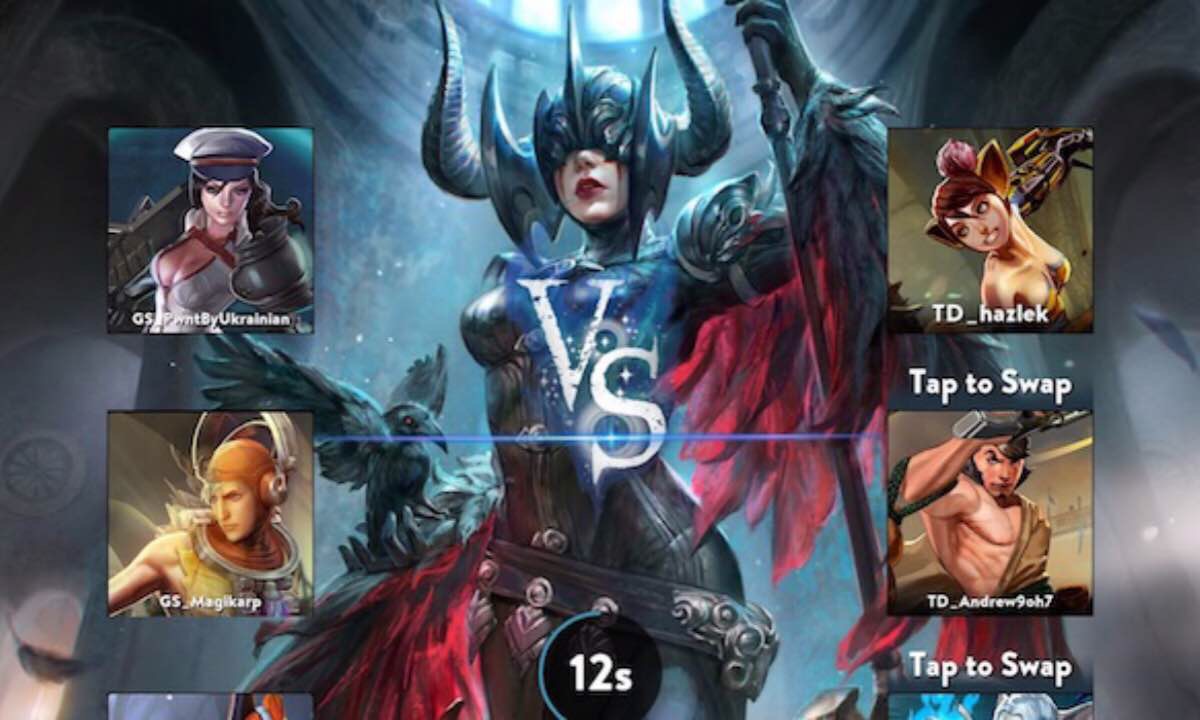
4 Comments
Alfred
Apr 27, 2018 5:08 ammake this again but for 5v5 :v
Sean
Apr 28, 2018 10:28 amWorking on it! 🙂
redstonepizza
Feb 08, 2016 8:31 amReally great article! It’s so difficult to get draft pick though. And what about the poop strat? (Push comp)
Khaos
Feb 08, 2016 9:02 amI supposed that would be the “Death Ball” and/or “One Man Army” type comp.